Your existing customers are invaluable sources of revenue growth.
Like plants in your garden, they need nurturing. When you take care of your customers, you help them grow abundantly. Without proper care, they will wither and … disappear.
That’s why you need to water them – provide value, remove weeds – solve problems, and maybe add some fertilizer – offer incentives, to help them flourish and keep coming back for more – build loyalty.
This is what customer marketing is all about – nurturing relationships with existing customers to encourage repeat business, loyalty, and advocacy.
But to do that successfully, you need a mind shift.
Rather than the good old transaction-based approach to B2B sales, you need to switch to the relationship-based model. Meaning that instead of focusing on new customers, you’re building your organization around long-term customers and repeat business.
In fact, focusing on existing customers has a huge impact on your bottom line, for example:
- Acquisition: Acquiring a new customer is 5 times more expensive than retaining an existing customer. By focusing on existing customers, you also lower your marketing costs.
- Retention: Improving customer retention rates by as little as 5% can increase profits between 25% and 95%. Even a small increase in retention has a huge impact on growth.
- Revenue: The success rate of selling to a new customer is between 5-20%. Yet, the likelihood of selling to an existing customer is as high as 60-70%. It’s far cheaper (and easier) to cross-sell and upsell products and services to existing customers, as repeat customers spend 67% more than new customers.
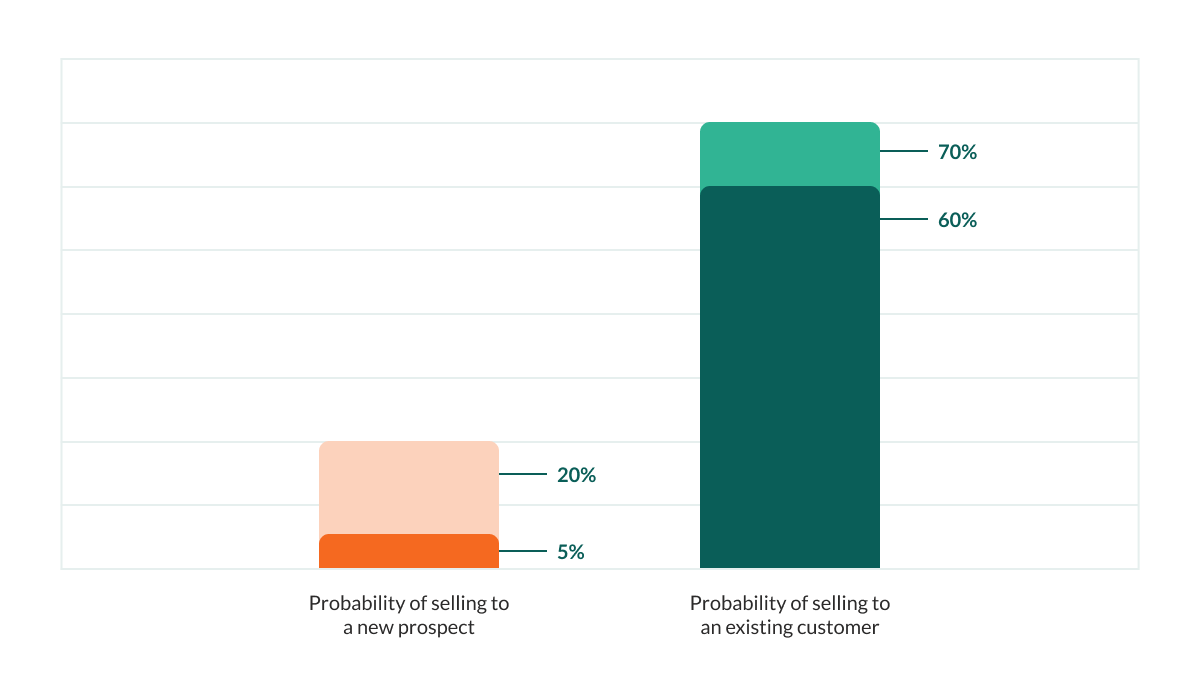
What is customer marketing?
Customer marketing is a strategy that focuses on keeping customers happy to encourage repeat business, loyalty, and advocacy.
Differently to “traditional marketing” that aims mostly to attract new customers, customer marketing targets existing customers, aiming to maximize their lifetime value and turn them into brand advocates.
Think about it: Would you rather have 100 new customers who purchase once in their lifetime, or 20 high-quality customers who continue to support your business for years to come? The answer is obvious!
If we revisit the relationship loop, traditional marketing is about getting noticed and shortlisted in the buying process of a potential customer. Customer marketing slightly differs in the fact that it is about enhancing their overall customer experience and building loyalty.
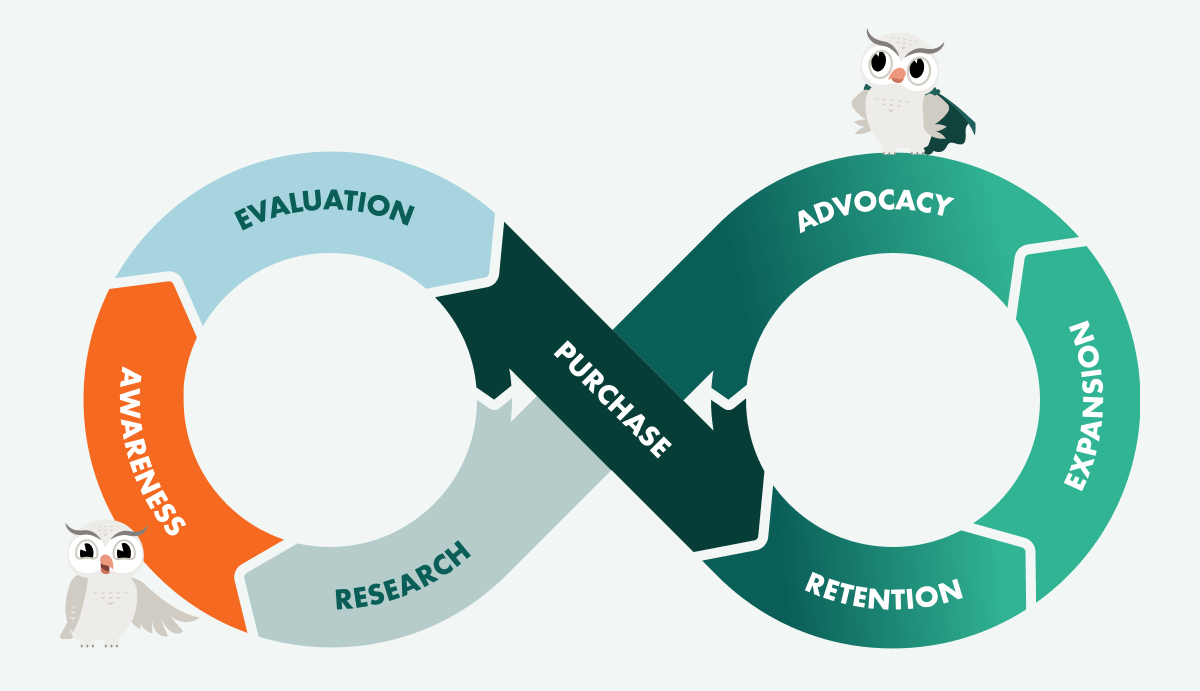
It’s important to note that customer marketing is “the customer” part of a more comprehensive relationship loop – a strategy that spans throughout the entire journey a customer takes with a brand: from being a prospect to becoming an advocate.
So, instead of focusing on all 7 stages of the customer journey, customer marketing takes case of the last (super important!) 3 stages.
Apart from the general engagement, customer marketing is designed to:
- show customers how they can get the most value out of your products
- create positive experiences to keep customers satisfied for the long-term
- reduce churn, improve retention rates, and increase in revenue and profits
But customer marketing isn’t a one-off isolated activity. It encompasses the entire post-purchase process of the customer journey, with a focus on building quality relationships with customers through adoption, retention, expansion and advocacy.
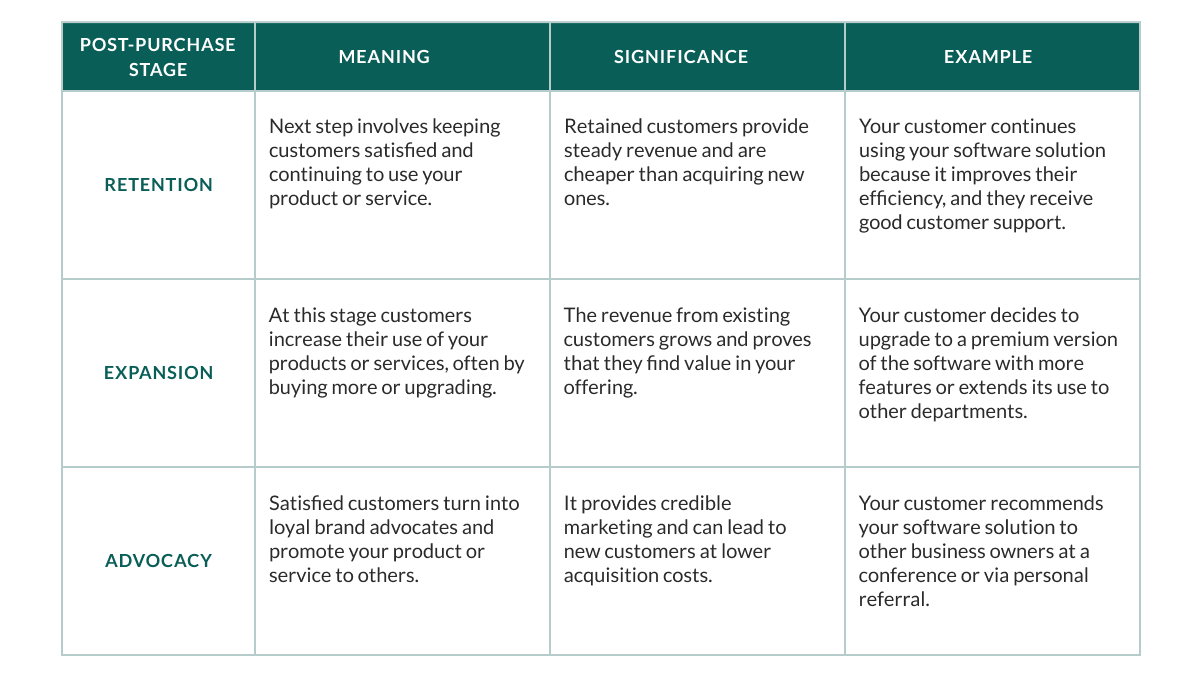
Customer marketing tactics for the post-purchase phase
Let’s take a closer look at some effective customer marketing tactics that B2B companies can weave into each post-purchase stage.
Retention
Exclusive content that offers valuable insights into the customer’s industry, like reports, eBooks, white papers, blogs, or best practice guides that help customers stay ahead in their field.
Free webinars and live events that help customers discover new ways of using your product more effectively, understand the new business challenges and find innovative solutions to emerging problems.
Customer success stories and testimonials that highlight how other customers have succeeded with your product.
Customer feedback and surveys that demonstrate you are interested in and value the opinions of your customers and are ready to make improvements.
Expansion
Account-based marketing that creates dedicated resources on a select group of high-value accounts via personalized marketing campaigns. Here the focus is on quality over quantity and multi-channel engagement, which helps build deeper and longer relationships.
Cross-selling, upselling, and usage-based recommendations via such methods as content pieces or email campaigns that explain the benefits of additional products or upgraded features, as well as suggest improvements or expansions based on user habits.
Advocacy
Referral programs that offer incentives for customers who bring in new business.
Community building involves creating forums, social media groups, or events where customers can connect with each other and the company.
Customer involvement that involves inviting a successful customer to live events as a keynote speaker to share their knowledge and success.
Advocate empowerment programs involve you offering your brand ambassadors (advocate) with marketing materials, social media content suggestions, and talking points to make advocating easier and more impactful.
💡 All these customer marketing tactics bring a host of benefits, if done right and at the right time! For that you need to understand your existing customer base, the phases they are going through, and their changing (evolving) needs.
In the long-term, customer marketing can lead to higher customer lifetime value and reveal new opportunities, such as product improvement or even market expansion.
But it’s time to switch from tactical to more strategic thinking.
Three customer marketing strategies
Depending on the types of customers you have, your customer marketing strategies will fall into one of the following: high touch, tech touch and low touch.
Let’s explore each of them.
1. High touch
If your customers are high value, VIP, or what you consider “enterprise” level, the best customer marketing strategy to execute on is known as “high touch”.
High touch customer marketing requires regular contact and in-person communication designed to make your customers feel cared for and valued, so they continue to buy from you in the long term.
This approach is best for customers who need more support and attention, often seen in industries with complex products or services.
This form of communication isn’t about self-service or live chat support.
What you’re offering here is real human contact that can evolve into a long-term business relationship. You pick up the phone and check-in, you meet up in person regularly, you follow up, and prioritize their needs over yours.
Examples of high touch customer marketing strategies that you can start using today include:
- Offer 24/7 customer support
- Dedicated account management
- Regular check-ins and in-person training or onboarding
- Customized product implementation or installation
- Customer conferences and events to build your relationships
At SuperOffice, we love meeting with our existing and potential customers live. Naturally, once the pandemic subsided, we returned to hosting events.
For the last two years, we’ve been organizing SuperOffice CRM Tour called “CHANGE” – a series of local events in our main markets, featuring a host of motivational speakers and business leaders.
We invite our guests to join us as we learn together how to navigate the changing business environment and find ways to sustainable growth, as well as discuss other pressing topics such as AI, new leadership approaches, or more holistic business development strategies.

2. Tech touch
If your customers spend less than a few hundred dollars per month, the high touch marketing strategy is the fastest way to lose money.
Why? Because instead of spending budget and time on connecting with your customers one-on-one, you can find a solution that allows you to reach a high volume of customers both cost-effectively and quickly, without the need for “hand holding”.
This is where tech touch marketing comes in. It uses technology to manage customer relationships.
The tech tough strategy is effective for reaching a large number of customers efficiently, often using automated tools and software.
You can quickly create scalable customer marketing campaigns that can be optimized over time to fine-tune the results it delivers and improve performance. Moreover, you can tie marketing campaign data back to product usage to witness the full extent of the impact on your marketing strategy.
If you’d like to use the tech touch marketing strategy, you can:
- Run online ads to encourage existing customers to unlock new features or upgrade existing accounts
- Use in-app messaging and notifications to alert users to product improvements
- Create a suite of online training materials to help customers get as much value as possible from your product
- Use triggered emails to notify customers of usage milestones, send product news, or reactivation campaigns
- Share product updates, how-to guides and useful content on social media to a private group of customers
That's why SuperOffice customers have access to a dedicated Customer Community – a platform created by our centralized content team where we publish product updates and, tips and tricks – to help our customers get the most out of their CRM.
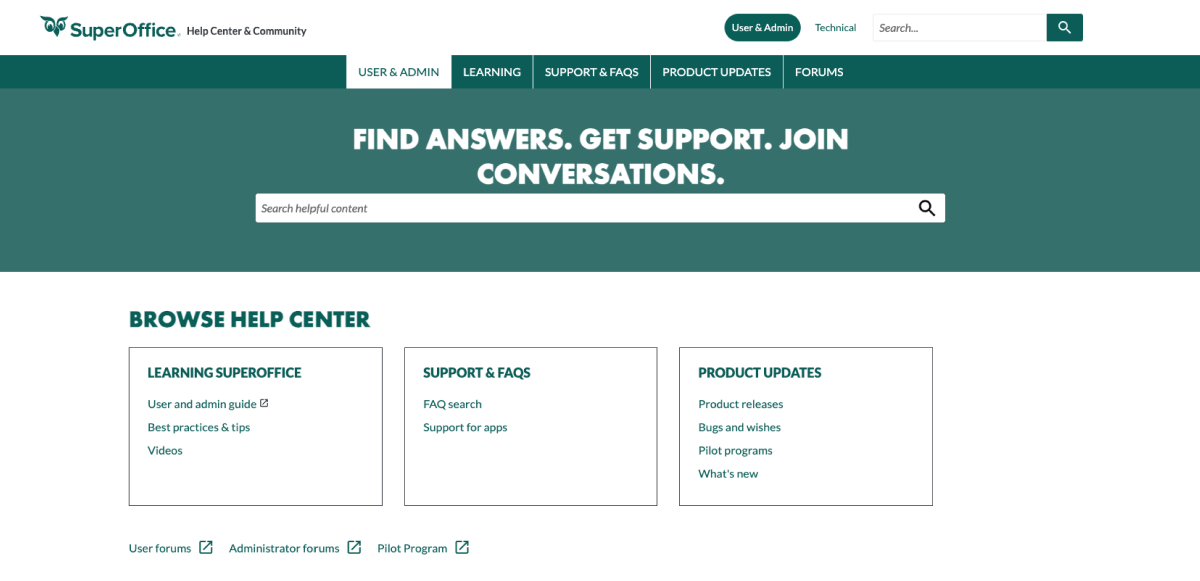
Asking customers what they want and how is a great example of the voice of the customer feedback.
3. Low touch
Low touch customer marketing is best suited for customers that aren’t quite experienced but have the potential to grow and become high value clients and, therefore, require more nurturing than just online training or digital content.
Low touch customer marketing requires minimal interaction and support. It’s more hands-off, letting customers manage on their own.
Low touch customer marketing is a carefully selected blend of strategies from both the high touch and tech touch methodologies outlined above. For example:
- Educational content such as webinars, tutorials, blog posts, and an email series to help your customers learn more about your product.
- Live chat customer support to enable your customers to contact you quickly if they have any problems or questions about your product.
- FAQ pages to cater for customers who prefer to solve problems on their own and not to contact a member of your team for help.
- Account management activities, such as regular check-in emails or calls to keep communication channels open (schedule these at varying intervals depending on the importance of your client).
- Email and in-product cross-selling and promotion based on user behavior to target specific customers with relevant offers.
- Set up customer self-service portals (online platforms) where customers can find information, manage their accounts, and get support.
Our customer success team has developed SuperOffice Customer Center – a 24/7 support portal where we combine live chat support with a vast repository of FAQs in our Knowledge base and, where appropriate, provide access to calls and emails from account managers and the customer success team.
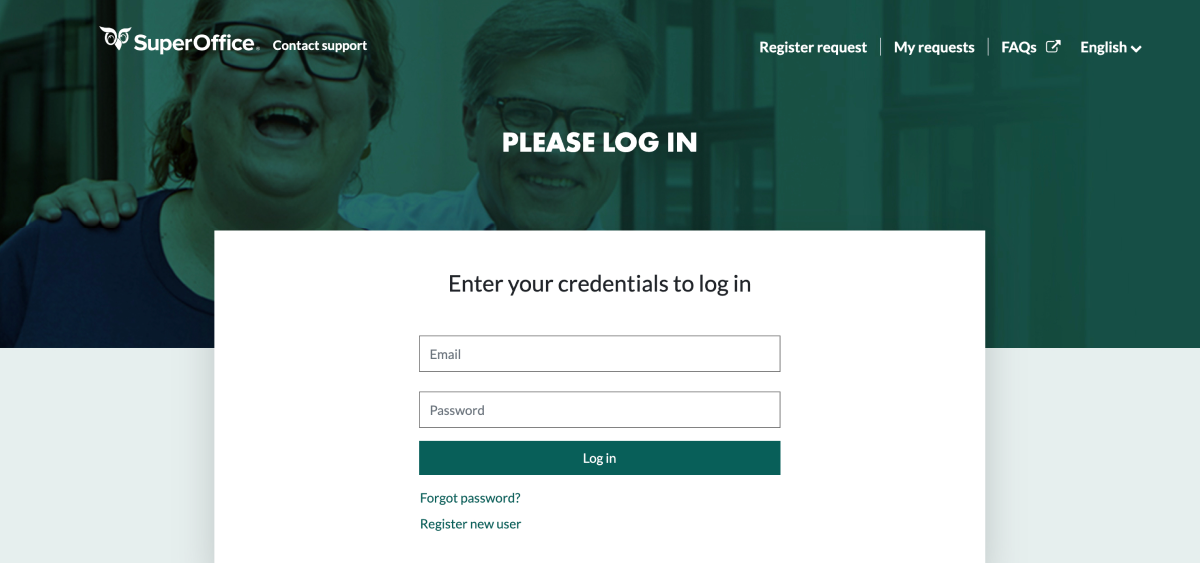
This means our customers always have a way to get help from us – whether in human or digital form.
Conclusion
Whether you’re focusing on high touch, tech touch, or low touch customer marketing, the main takeaway is – you need to shape your strategies, messaging and format to suit your customers.
There is no “one size fits all” way of doing customer marketing, so you’ll need to experiment and adapt your methods over time in order to make sure they work for you and your customers.
- High touch is great for building deep, long-lasting relationships.
- Tech touch is efficient for scaling interactions and maximizing customer value.
- Low touch is cost-effective for maintaining connections and customer satisfaction.
However, the underlying concept for a successful customer marketing strategy is that you cannot achieve long-term sustainable growth through customer acquisition only.
Remember, customer marketing isn’t a one-off strategy. Start off simple – whether it’s the high touch approach for ‘enterprise’ clients, tech touch for ‘low tier’ customers, or a blended mix for your mid-tier customers.
Not only is customer marketing a cheaper and more effective way to do business, but it's a proven enabler for rapid, sustainable growth.
If you're new to SuperOffice and would like to learn more about our CRM solution, then sign up to a personalized demo.



